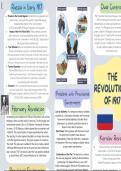1. Russia in Early 1917 Dual Contro
Threats to the Tsarist Regime: Discontent among peasants and The Provisional Government however had
urban workers, along with the growth of opposition groups, with the Petrograd Soviet which was m
weakened the stability of the Tsarist regime. representatives of workers and soldiers to lo
In 1917, about 80% of Russian Population were peasants interests. The Petrograd Soviet controlled
Impact of the First World War: Military defeats, economic system, soldiers in Petrograd Garrison and t
strain, and social unrest exacerbated by the war, with the Tsar telegraph service. Therefore the Provisional
assuming the role of commander-in-chief. By 1917, large areas of had little power. Kerensky was a lawyer an
the Russian Empire had been lost. socialist. He was a “middle man” in both or
Tsar Nicholas II was an incompetent ruler who contributed to he was a skillfull speaker yet made mist
Russia‘s downfall by refusing to relinquish absolute power. continuing the war.
Nicholas declared himself Commander in Chief of the army and
departed for the Eastern Front to take control of operations.
However, Nicholas was not well educated in the tactics of war.
Tsarina Alexandra was left in control and was unpopular, she
favoured those loyal to her over competent leaders, further
THE
weakening the government. The infamous Rasputin's sway
over the Tsarina tarnished the royal family's reputation,
exacerbating public discontent.
REVOLUTIO
Economic Vital raw materials became scarce due to disrupted
overseas supply lines. Huge food shortages: before 1914,
2,200 wagons of grain a months by Feb 1917 it was fewer than
Problems with Provisional
OF 1917
700. By 1916, inflation had reached 200%.
Government
February Revolution Lack of Authority: As a temporary measure awaiting
Immediate causes leading to the February Revolution, such as food elections for a Constituent Assembly, the Provisional
shortages, strikes, and the mutiny in the army. The final trigger was Government lacked legitimacy and often faced
International woman’s day, on 23 February- thousands of women challenges to its authority, particularly due to its
on street. On 26 February, soldiers opened dire on protesters and failure to set a date for elections.
killed 40. This caused soldiers to begin questioning their orders. Dual Power: Sharing power with the Soviet meant
the government couldn't make decisions
The next day, the same regiment decided to no longer obey orders
and other regiments joined in. They gave weapons to crowds on independently. Orders like Order No. 1 weakened
the discipline of the army, leading to soldiers' refusal
Kornilov Revo
the street. The duma sent a petition to the tsar to create a cabinet
reflecting different parties due to the upset and also let the duma to obey orders and desertion. General Kornilov had recently been
stay in session. The Tsar refused. Later the Tsar agreed to abdicate Commander-in-Chief of the Russian
on 2nd of March 1917 and did officially on the 15th March . Continuation of the War: The decision to continue Kerensky. He planned a revolt where he
the war was unpopular, leading to demonstrations -Create a strong government
and disorder. The failed offensive in June 1917 -Defeat Revolutionary groups in Petro
further eroded support. Where the PG ordered a new
attack which was a disaster and Russian Soldiers





